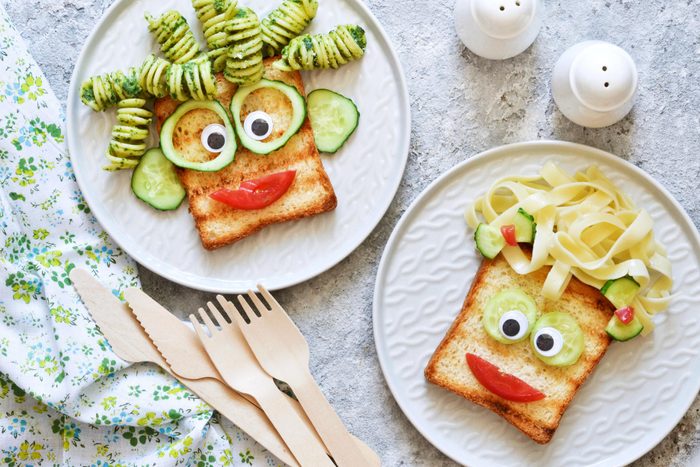
Take a bite out of these funny food names
There’s no shortage of astonishing food facts out there to delight and amaze your brain. Take, for instance, these food-origin tidbits: Did you know that Caesar salad has nothing to do with the famous Roman emperor? Or that the name Häagen-Dazs is completely made up? There are plenty of other funny food names, and many come with highly amusing origin stories. (Go ahead: Get those food jokes ready.)
With that in mind, we’re rounding up some of the best names that have crossed our plates. They may not be America’s favorite foods, but they sure are some of the funniest. Here are the facts behind some funny food names you may have always been curious about.
Get Reader’s Digest’s Read Up newsletter for more food, humor, cleaning, travel, tech and fun facts all week long.
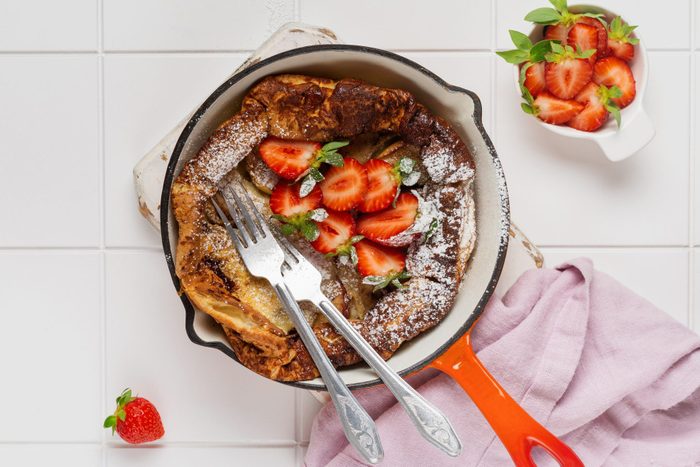
Dutch babies
Pancakes are universally beloved, with every country putting its own spin on this breakfast favorite. The Dutch baby is one such dish, yet it does not hail from the Netherlands, nor is it the size of an actual baby (thank goodness!). So, what is a Dutch baby, exactly? Also referred to as a German pancake, or pfannkuchen, this puffy pancake has a thin, water-rich batter reminiscent of crepes and popovers. As it bakes—in a skillet or cast-iron pan in an ultra-hot oven—the water quickly evaporates, causing the Dutch baby to puff up like a fluffy cloud.
So where does the name come from? According to culinary lore, it’s all thanks to the daughter of a Seattle restaurateur who put German pancakes on the menu; she accidentally mispronounced “Deutsch” (the German word for German) as “Dutch.” When the eatery downsized its pancakes to single-servings, it affectionately began calling them “Dutch babies.”

Bubble and squeak
Typically made from leftover vegetables, particularly those from a Sunday roast dinner, bubble and squeak is an iconic dish from across the pond. And like many other British food names, it’s utterly adorable. The term comes from the sounds it makes when cooking. As the vegetables—often including potatoes, cabbage, Brussels sprouts or any other available leftovers—cook, they release liquids that bubble as they boil. Eventually, all the liquid evaporates, and the wilted vegetables squeak as they fry in the hot pan.
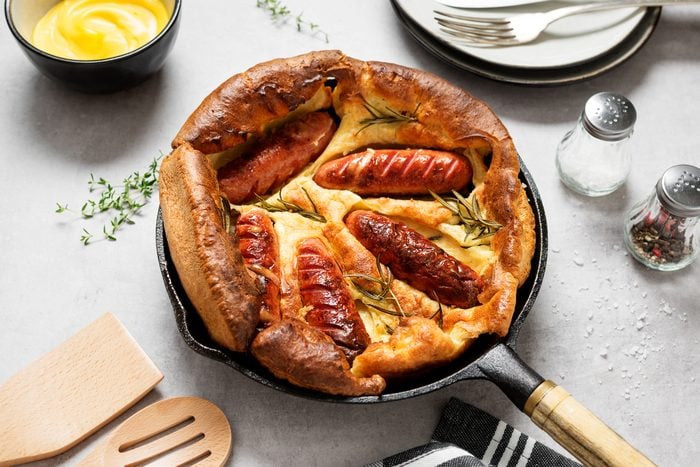
Toad-in-the-hole
The name toad-in-the-hole might conjure up images of fat brown frogs, but not a single amphibian is harmed when making this classic British dish. Instead, it is made with succulent sausages nestled within a puffy, golden-brown Yorkshire pudding. The batter, made from flour, eggs and milk, is poured over the sausages, allowing them to cook and infuse the batter with their savory essence. The dish likely acquired its whimsical name due to its resemblance to a toad poking its head out from a burrow.
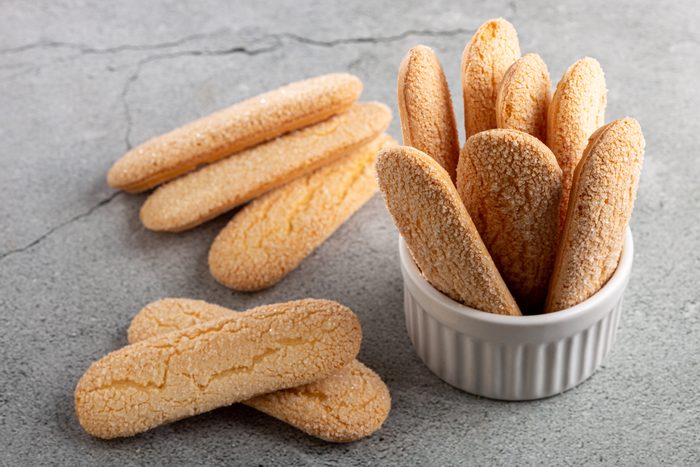
Ladyfingers
Have you always assumed light, delicate ladyfingers were named for the light, delicate fingers of a lady? Well, you’re right! These cake-like biscuits were enjoyed by highborn noblewomen (and gents) during the Italian Renaissance, where they were known as savoiardi. In late 19th-century France, they were called biscuits à la cuiller—or “spoon biscuits”—because their shape made them ideal for spooning soft desserts like custard and mousse. Once their popularity spread to England, they took on the name ladyfingers, partially because of their association with sophisticated women who enjoyed them at high tea and partially because their slender shape and delicate nature are reminiscent of a lady’s fingers. If you’re the sort of snack fiend who loves cookies and milk, you’ll find a new favorite in this funny-named food.
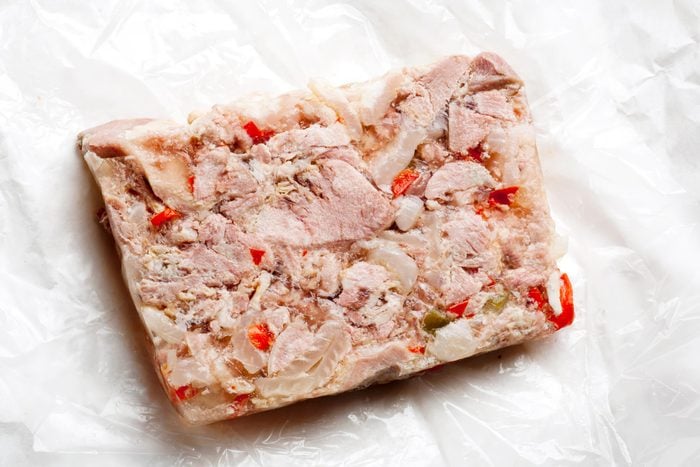
Headcheese
Unlike many of the other funny food names on this list, headcheese’s interesting name is partially correct. Though it is sliceable like cheese, it is not even remotely related to it. In fact, headcheese doesn’t contain a single drop of dairy.
What it does contain is heads—hog’s heads, in particular—that have been cooked slowly until their meat becomes tender and falls off the skulls. (Before you get grossed out, remember that all meat comes from some part of an animal!) As the head cooks, its collagen melts and turns into gelatin, which is then poured into a mold with the meat and left to set into a solid, sliceable block. It’s believed that early recipes used cheese molds to shape headcheese, thus giving this food its funny name.

Sweetbreads
Here’s a head-scratcher: Sweetbreads, despite their deceiving name, are neither sweet nor bread. In fact, they’re just about the furthest thing from it. Sweetbreads are offal—specifically, the thymus and pancreas glands of calves or lambs.
The first recorded mention of the name “sweetbreads” comes from a 16th-century British text. Back then, the term bread (also spelled as “brede”) referred to roasted or grilled meats. Compared with other, tougher cuts of meat, sweetbreads are tender enough to cut with a fork and may have been called “sweet” to differentiate their delicacy from roasts, shanks and other cuts that required more cooking to become edible.
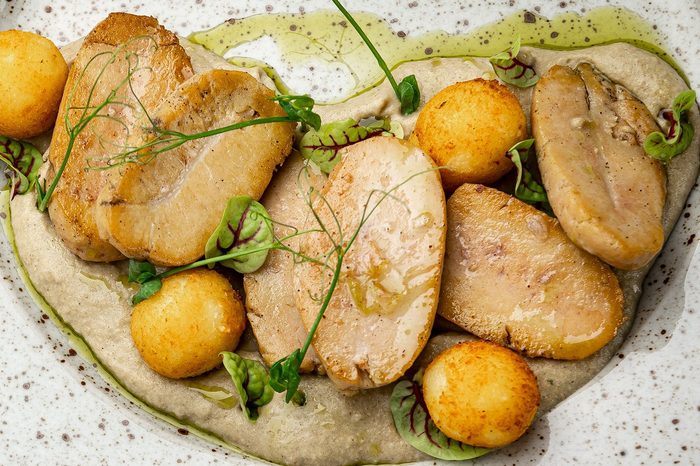
Rocky Mountain oysters
Though the term oyster might conjure images of succulent seafood treasures from the ocean, Rocky Mountain oysters are nothing of the sort. In fact, they’re not from the ocean at all. They are—and please brace yourself for this revelation—bull testicles. Yes, you read that correctly. They’re testicles. (And you thought eating oysters was a daunting prospect.)
You probably wouldn’t be surprised if some enterprising chefs gave bull testicles a nickname to make them more appetizing. It’s certainly one of the more disgusting foods on this list of funny food names. But that’s not part of the history of this food. So where does the misnomer come from? This dish is a specialty of the American West, which is why it’s associated with the Rocky Mountains. Legend has it that early pioneers and ranchers—who often ate every part of the cow out of necessity—coined the name as a joke, likening the bull testicles to the prized seafood. In case you’re curious: No, they taste nothing like oysters.
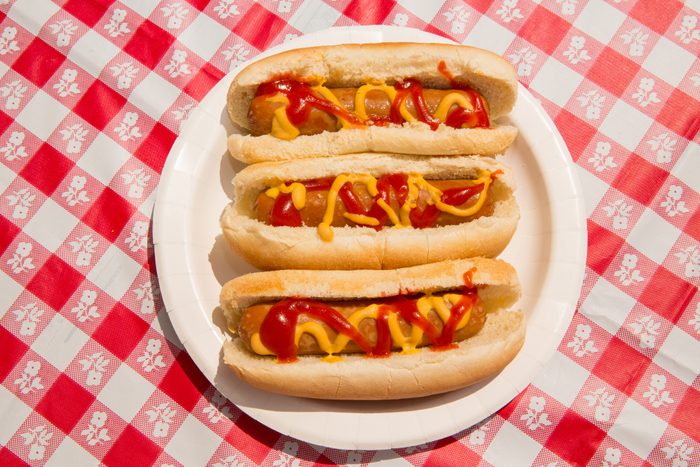
Hot dogs
How did hot dogs get their name when there are (thankfully) no dogs involved? Some believe the name began as a joke: Hot dogs were a cheap, affordable meal popular with the working class, and with few people knowing how hot dogs are made, the implication was that dog meat was used to keep them cheap.
A more likely explanation is that the German butchers behind early American frankfurters noted the resemblance between their slender sausages and dachshunds. They nicknamed their delicious creation “dachshund sausages,” and over time, the name gradually morphed into the shorter, snazzier “hot dogs.” Interested in learning more fun hot dog facts? Find out why there are 10 hot dogs in a pack but only eight buns.
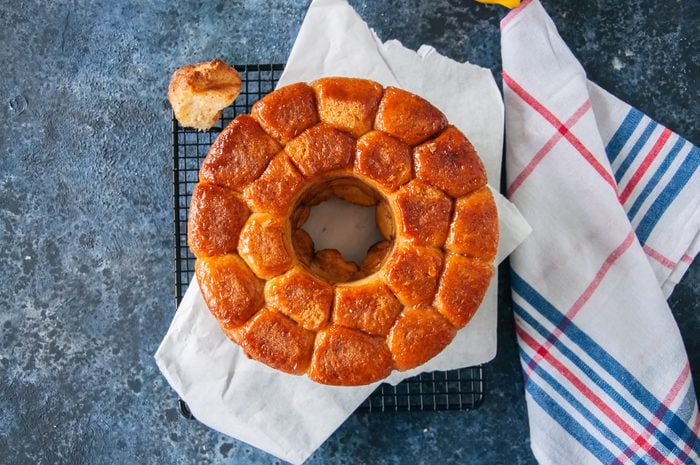
Monkey bread
When it comes to funny food names, this is one misnomer that won’t leave you gagging with disgust. It doesn’t have anything to do with monkeys, and that’s a good thing, because this is one tasty treat.
Monkey bread consists of bite-sized pieces of dough that are rolled in sugar and cinnamon, then baked together in a Bundt pan to form a soft and sticky delight. There’s no definitive answer as to why it’s called monkey bread, but one popular theory suggests it refers to the bread’s interactive and playful nature. Another theory proposes that once the individual cinnamon-coated dough balls rise and expand, they create a texture reminiscent of a monkey’s furry coat.
If you want to make monkey bread that feels a little more true to its name, try layering your dough balls with chopped up bananas. (And maybe add some chocolate chips, while you’re at it.)
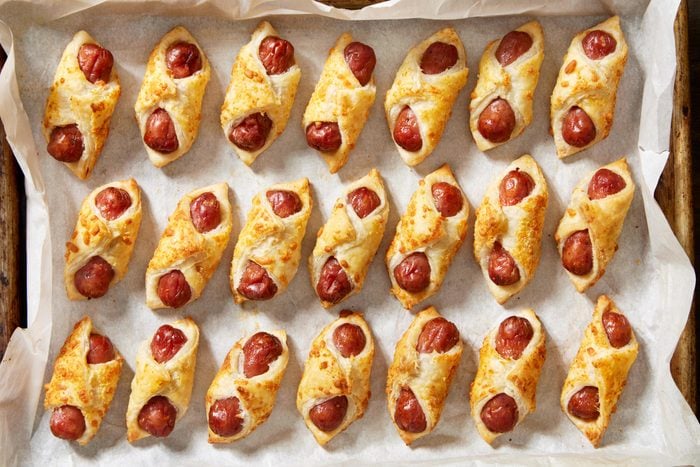
Pigs in a blanket
Pigs in a blanket are hot dogs perfected, which is why they’ve been a popular party food for decades. What fun would a cocktail party or Super Bowl shindig be without a hot platter of these perfectly poppable franks? The name is cute—fitting for an easy finger food that’s mostly associated with celebrations and festive times. It’s also relatively accurate: The “pigs” are mini hot dogs made with pork, and they’re swaddled in warm “blankets” of buttery biscuit dough or puff pastry.
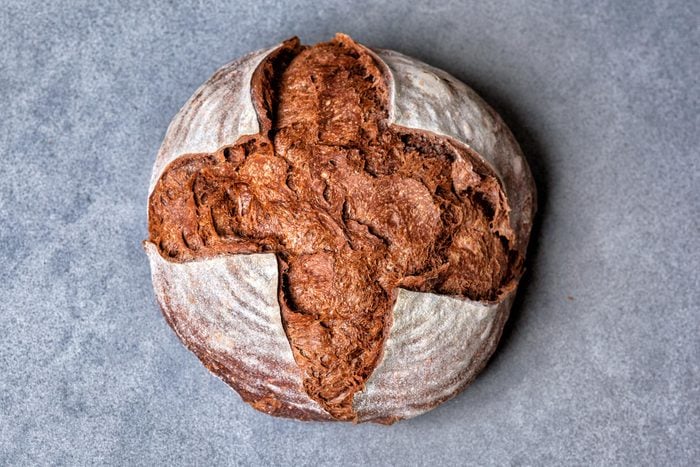
Pumpernickel
Of all the types of bread in the world, pumpernickel might be the most fun to say out loud. This dark, hearty loaf has German roots and is made with a combination of rye flour, molasses and sourdough starter. There are two theories as to where its amusing name comes from. One involves a legend about a man and his trusty horse, Nicol. In a version popular on the internet, said man is Napoleon Bonaparte. When the French army was making its way across Northern Europe, the general received pumpernickel bread at dinner, which he promptly spit out in disgust, declaring it inedible for humans but “Bon pour Nicol.” (Translation: “Good for Nicole.”)
The more likely explanation is related to one of the most notorious side effects of the original pumpernickel bread recipe: flatulence. In German, the word pumpern means “to break wind,” and nickel refers to a mischievous imp or devil. Put them both together, and you have a bread named “devil’s fart.” (If you’re concerned about getting the toots, know that the recipe for modern-day pumpernickel has done away with the ingredients responsible for excessive gassiness.)
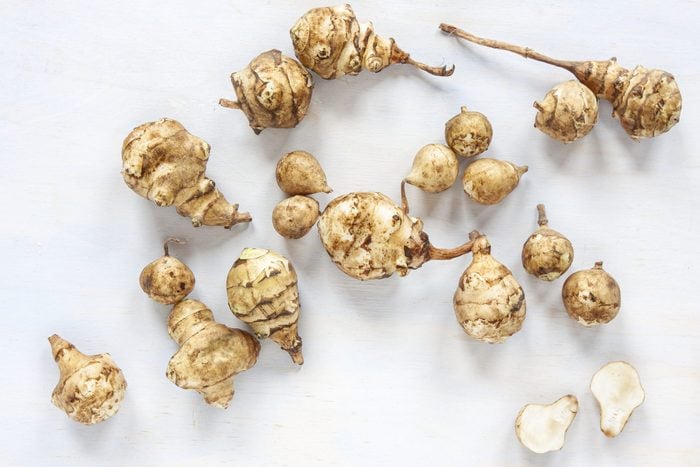
Jerusalem artichokes
Based on their name, you might think Jerusalem artichokes originate from Israel, but you’d be wrong! This bumpy root crop, a member of the sunflower species, has absolutely nothing to do with Jerusalem—it’s native to North America. It also bears no resemblance to artichokes, which makes sense considering the two vegetables aren’t even related! So how did these tasty tubers get a name that’s blatantly wrong not once but twice?
In the early 1600s, Indigenous Americans (who gave them the far more accurate name of “sunroots”) introduced Jerusalem artichokes to French explorers, who then brought them back to Europe. There, Italian chefs named them girasole, which means “sunflower.” But as the vegetable spread past Italy, people continually mispronounced the name, and over time girasole transformed into “Jerusalem.” As for the artichoke part, chefs noted that the flavor of this root vegetable was somewhat reminiscent of artichokes (which are members of the thistle family), so they added the name as a descriptor.
Ready to try some Jerusalem artichokes? Before you shop, be sure you know how to store vegetables properly!
Sources:
- Atlas Obscura: “Dutch Baby”
- Culinary Lore: “Origin of the Word Pumpernickel”
- What’s Cooking America: “Ladyfinger Cakes History”
- Food Timeline: “Sweetbreads”
- Atlas Obscura: “Rocky Mountain Oysters”
- The University of Vermont: “The Jerusalem Artichoke: An Unsung Hero”
